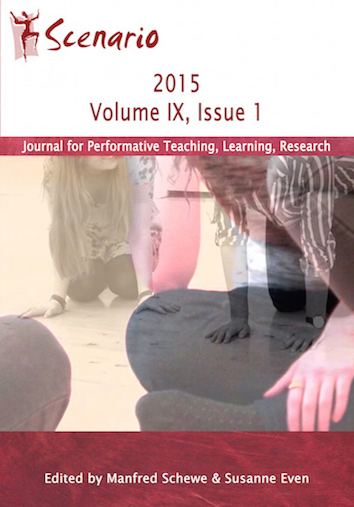Sounds in the Foreign Language Lesson
DOI:
https://doi.org/10.33178/scenario.9.1.4Abstract
Modern teaching approaches such as CLIL and various European policies (Council of Europe 2014) promote the vision of a multilingual school where the new European citizen can grow up learning at least two languages besides their mother tongue(s). From the point of view of foreign language teaching, especially interesting is the use of the arts (theatre, drama, music, dance, and fine arts), whether to create a new approach to teaching and learning (Schewe 2013) or to increase the motivation and commitment of the learners (Fleming 2014). In order for schools and teachers to be able to make use of the performing arts and modify their teaching methods accordingly, however, it will be necessary for government bodies and universities to modify and enrich teacher education – not just initial education but also continuing education – with special courses, workshops, and conferences. Language and music are two worlds that are strongly interconnected. According to Patel (2008: 3), both of these worlds define us as human because both of them appear in every human society, no matter what other aspects of culture may be absent. Even the smallest, most isolated tribes, like the Pirahã in Brazil, have music and songs in abundance though ...References
Anvari, Sima H.; Trainor, Laurel K.; Woodside, Jennifer; Levy, Betty Ann (2002): Relations among musical skills, phonological processing and early reading ability in preschool children. In: Journal of Experiment Child Psychology 83, 111-130
Council of Europe (2014): Recommendation CM/Rec(2014)5 of the Committee of Ministers to member States on the importance of competences in the language(s) of schooling for equity and quality in education and for educational success. Strasbourg: Council of Europe
Everett, Daniel L. (2005): Cultural constraints on grammar and cognition in Pirahã: Another look at the design features of human language. In: Current Anthropology 46, 621-646
Fleming, Michael (2014): Language learning and the performing arts: issues of justification. In: Nofri, Carlo & Stracci, Moreno (eds.): Performing Arts in Language Learning. Proceedings of the International Conference. Rome: Novacultur, 29-37
Hannon, Erin & Trainor, Laurel (2007): Music acquisition: Effects of enculturation and formal training on development. In: Trends in Cognitive Sciences 11(11), 466-472
Koelsch, Stefan & Siebel, Walter A. (2005): Towards a neural basis of music perception. In: Trends in Cognitive Science 9, 578-584
Maule, Elita; Cavagnoli, Stefania &Lucchetti, Stefania (2006): Musica e apprendimento linguistico. Bergamo: Junior
Maule, Elita; Bertacchini, Carla & Viel, Massimiliano (2007): Parole, suoni e musiche. Bergamo: Junior
Patel, Aniruddh D. (2008): Music, language and the brain. Oxford: Oxford University Press
Piro, Joseph & Ortiz, Camilo (2009): The effect of piano lessons on the vocabulary and verbal sequencing skills of primary grade students. In: Psychology of Music 37(3), 325-347
Schewe, Manfred (2013): Taking Stock and Looking Ahead: Drama Pedagogy as a Gateway to a Performative Teaching and Learning Culture. In: Scenario VII(1), 5-28
Stewart, David W. (1998): Effects of using a nonverbal (musical) cue on recall and playback of television advertising: Implications for advertising tracking. In: Journal of Business Research 42, 39-51
Tomatis, Alfred (1993): Dalla Comunicazione intrauterina al linguaggio umano. Como: Ibis
Wallace, Wanda T. (1994): Memory for music: Effect of melody on recall. In: Journal of Experimental Psychology 20(6), 1471-1485
Published
Issue
Section
License
Copyright (c) 2015 the author(s)

This work is licensed under a Creative Commons Attribution-NonCommercial-NoDerivatives 4.0 International License.







